AMD Ryzen 9 5980HS Cezanne Review: Ryzen 5000 Mobile Tested
by Dr. Ian Cutress on January 26, 2021 9:00 AM EST- Posted in
- CPUs
- AMD
- Vega
- Ryzen
- Zen 3
- Renoir
- Notebook
- Ryzen 9 5980HS
- Ryzen 5000 Mobile
- Cezanne
CPU Tests: Simulation
Simulation and Science have a lot of overlap in the benchmarking world, however for this distinction we’re separating into two segments mostly based on the utility of the resulting data. The benchmarks that fall under Science have a distinct use for the data they output – in our Simulation section, these act more like synthetics but at some level are still trying to simulate a given environment.
DigiCortex v1.35: link
DigiCortex is a pet project for the visualization of neuron and synapse activity in the brain. The software comes with a variety of benchmark modes, and we take the small benchmark which runs a 32k neuron/1.8B synapse simulation, similar to a small slug.
The results on the output are given as a fraction of whether the system can simulate in real-time, so anything above a value of one is suitable for real-time work. The benchmark offers a 'no firing synapse' mode, which in essence detects DRAM and bus speed, however we take the firing mode which adds CPU work with every firing.
The software originally shipped with a benchmark that recorded the first few cycles and output a result. So while fast multi-threaded processors this made the benchmark last less than a few seconds, slow dual-core processors could be running for almost an hour. There is also the issue of DigiCortex starting with a base neuron/synapse map in ‘off mode’, giving a high result in the first few cycles as none of the nodes are currently active. We found that the performance settles down into a steady state after a while (when the model is actively in use), so we asked the author to allow for a ‘warm-up’ phase and for the benchmark to be the average over a second sample time.
For our test, we give the benchmark 20000 cycles to warm up and then take the data over the next 10000 cycles seconds for the test – on a modern processor this takes 30 seconds and 150 seconds respectively. This is then repeated a minimum of 10 times, with the first three results rejected. Results are shown as a multiple of real-time calculation.
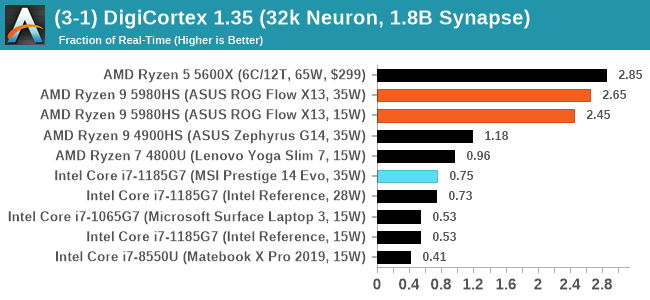
DigiCortex seems to have taken a shine to Zen 3, especially processors with a single chiplet of cores. Intel can't seem to compete here.
Dwarf Fortress 0.44.12: Link
Another long standing request for our benchmark suite has been Dwarf Fortress, a popular management/roguelike indie video game, first launched in 2006 and still being regularly updated today, aiming for a Steam launch sometime in the future.
Emulating the ASCII interfaces of old, this title is a rather complex beast, which can generate environments subject to millennia of rule, famous faces, peasants, and key historical figures and events. The further you get into the game, depending on the size of the world, the slower it becomes as it has to simulate more famous people, more world events, and the natural way that humanoid creatures take over an environment. Like some kind of virus.
For our test we’re using DFMark. DFMark is a benchmark built by vorsgren on the Bay12Forums that gives two different modes built on DFHack: world generation and embark. These tests can be configured, but range anywhere from 3 minutes to several hours. After analyzing the test, we ended up going for three different world generation sizes:
- Small, a 65x65 world with 250 years, 10 civilizations and 4 megabeasts
- Medium, a 127x127 world with 550 years, 10 civilizations and 4 megabeasts
- Large, a 257x257 world with 550 years, 40 civilizations and 10 megabeasts
DFMark outputs the time to run any given test, so this is what we use for the output. We loop the small test for as many times possible in 10 minutes, the medium test for as many times in 30 minutes, and the large test for as many times in an hour.
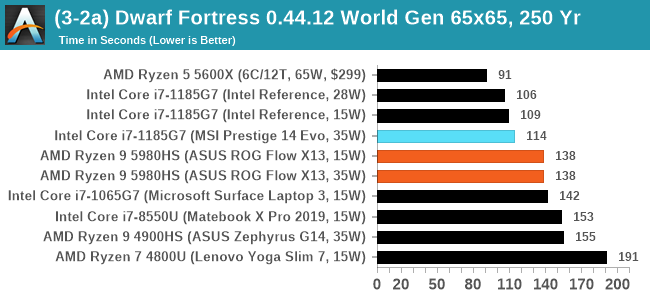
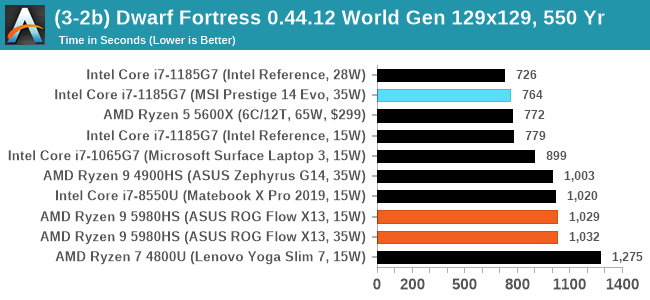
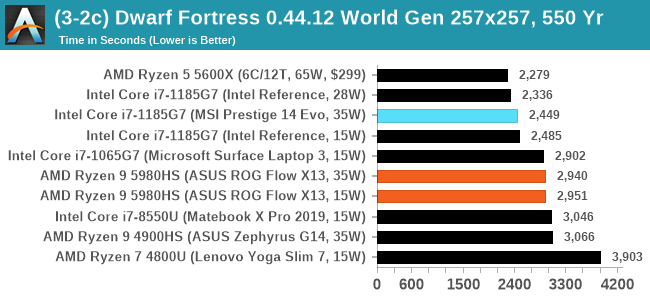
DF has historically been an Intel favorite, and we're not seeing much of a speedup for mobile Zen 3 over mobile Zen 2 here.
Dolphin v5.0 Emulation: Link
Many emulators are often bound by single thread CPU performance, and general reports tended to suggest that Haswell provided a significant boost to emulator performance. This benchmark runs a Wii program that ray traces a complex 3D scene inside the Dolphin Wii emulator. Performance on this benchmark is a good proxy of the speed of Dolphin CPU emulation, which is an intensive single core task using most aspects of a CPU. Results are given in seconds, where the Wii itself scores 1051 seconds.
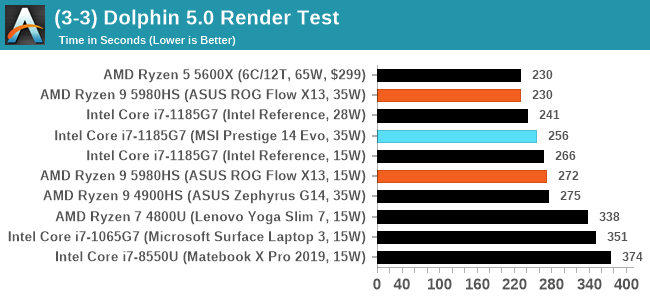
The 35W variant of Cezanne pushes through here, matching the desktop processor, and a sizeable performance jump over the previous generation Renoir.












218 Comments
View All Comments
Tomatotech - Thursday, January 28, 2021 - link
Wrong. Check Wikipedia - 2013 MacBook Pros were available from Apple with 1TB SSDs. They’re still good even now as you can replace that 2013 Apple SSD with a modern NVME SSD for a huge speed up.And yes Apple supported the NVMe standard before it was even a standard. It wasn’t finalised by 2013 so these macs need a $10 hardware adaptor in the m.2 bay to physically take the NVMe drive but electronically and on the software level NVME is fully supported.
Kuhar - Thursday, January 28, 2021 - link
Sorry but you are wrong or don`t understand what stock means. On Apple`s own website states clearly that MBP 2013 had STOCK 256 gb SSD with OPTION to upgrade to as high as 1 tb SSD. So maybe your Apple lies again and wiki is ofc correct. On top of that: bragging about 1 tb SSD when in PC world you could get 2 tb SSD in top machines isn`t rellay something to brag about.GreenReaper - Saturday, January 30, 2021 - link
Stock means that they were in stock, available from the manufacturer for order. Which is fair to apply in this case. Most likely they didn't have any SSD in them until they were configured upon sale.What you're thinking of is base. At the same time, it's fair to call out as an unfair comparison, because they are cited as the standard/base configuration of this model, where it wasn't for the MBP
grant3 - Wednesday, January 27, 2021 - link
1. Worrying about what was standard 7 years ago as if it's relevant to what people need today is silly2. TB SSDs were probably about $600-$700 in 2013. If you spent that much to upgrade your MBP, good for you, that doesn't mean it's the best use of funds for everyone.
Makste - Wednesday, January 27, 2021 - link
It is a good review thank you Dr. Ian.My concern is, and has always been the fact that, CPU manufacturers make beefier iGPUs on higher core count CPUs which is not right/fair in my view, because higher core count CPUs and most especially the H series are most of the time bundled with a dGPU, while lower core count CPUs may or may not be bundled with a dGPU. I think lower core count APUs would sell much better if the iGPUs on lower core count CPUs are made beefier because they have enough die space for this, I suppose, in order to satisfy clients who can only afford lower core count CPUs which are not paired with a dGPU. It's a bit of a waste of resources in my view to give 8 vega cores to a ryzen 9 5980HS which is going to be paired with a dgpu and only 6 vega cores to a ryzen 3 5300 whose prospects of being paired with a dGPU are limited.
I don't know what you think about this, but if you agree, then it'd be helpful if you managed to get them to reconsider. Thanks.
Spunjji - Thursday, January 28, 2021 - link
I get your point here, and I agree that it would be a nice thing to have - a 15W 4-core CPU with fully-enabled iGPU would be lovely. Unfortunately it doesn't make much sense from AMD's perspective - they only have one chip design, and they want to get as much money as possible for the fully-enabled ones. It would also add a lot of complexity to their product lineup to have some models that have more CPU cores and fewer GPU CUs, and some that reversed the balance. It's easier for them just to have one line-up that goes from worst to best. :/Makste - Thursday, January 28, 2021 - link
Yes. It could be that, they are sticking with their original plan from the time they decided to introduce iGPUs to X86. But, I don't see why they can't make an overhaul to their offerings now that they are also on top. They could still offer 8 vega dies from the beginning of the series to the top most 8 core cpu offering. And those would be the high end offerings.Then, the other mid and low end variants would be those without the fully enabled vega dies. This way, nothing would be wasted and cezanne would then have a multitude of offerings, I believe people, even at this moment, would like to own a piece of cezanne, be it 3 cores or 5 cores. I think it's the customer to decide what is valuable and what is not valuable. Black and white thinking won't do (that cores will only sell if they are in even numbers). They should simply offer everything they have especially since their design can allow them to do so and more so now that there are supply constraints.
Spunjji - Friday, January 29, 2021 - link
The problem is that it's not just about what the end-user might want. AMD's customers are the OEMs, and the OEMs don't want to build a range of laptops with several dozen CPU options in it, because then they have to keep stock of all of those processors and try to guess the right amount of laptops to build with each different option. It's just not efficient for them. Unfortunately, what you're asking for isn't likely to happen.Makste - Friday, January 29, 2021 - link
Sigh... I realise the cold hard truth now that you've put it more bluntly....An OEM has to fill this gap.
Spunjji - Thursday, January 28, 2021 - link
I might be in the market for a laptop later this year, and it's nice to know that unlike the jump from Zen+ to Zen 2, the newer APUs are better but not *devastatingly so*. I might be able to pick up something using a 4000 series APU on discount and not feel like I'm missing out, but if funds allow I can go for a new device with a 5000 APU and know that I'm getting the absolute best mobile x86 performance per watt/dollar on the market. Either way, it's good to see that the Intel/Nvidia duopoly is finally being broken in a meaningful way.I do have one request - it would be nice to get a separate article with a little more analysis on Tiger Lake in shipping devices vs. the preview device they sent you. Your preview model appears to absolutely annihilate its own very close retail cousin here, and I'd love to see some informed thoughts on how and why that happens. I really don't like the fact that Intel seeded reviewers with something that, in retrospect, appears to significantly over-represent the performance of actually shipping products. It would be good to know whether that's a fluke or something you can replicate consistently - and, if it's the latter, for that to be called out more prominently.
Regardless, thanks for the efforts. It's good to see AMD maintaining good pace. When they get around to slapping RDNA 2 into a future APU, I might finally go ahead and replace my media centre with something that can game!